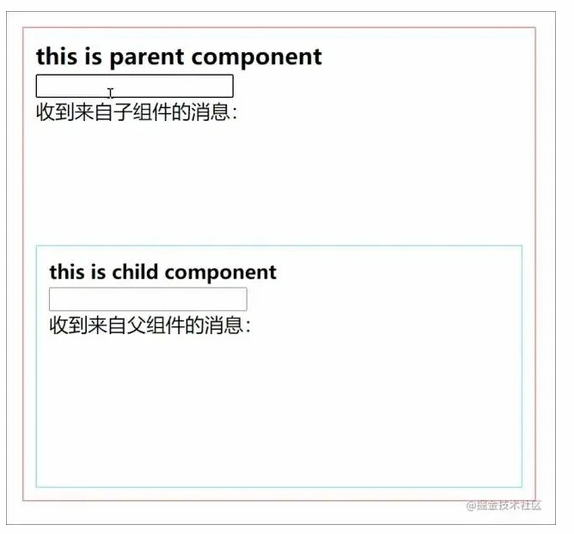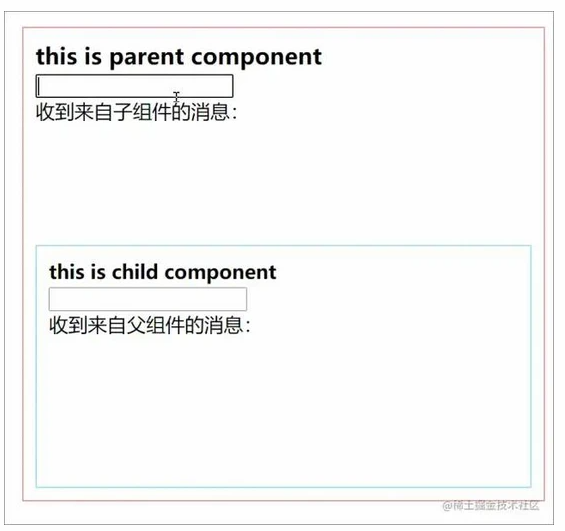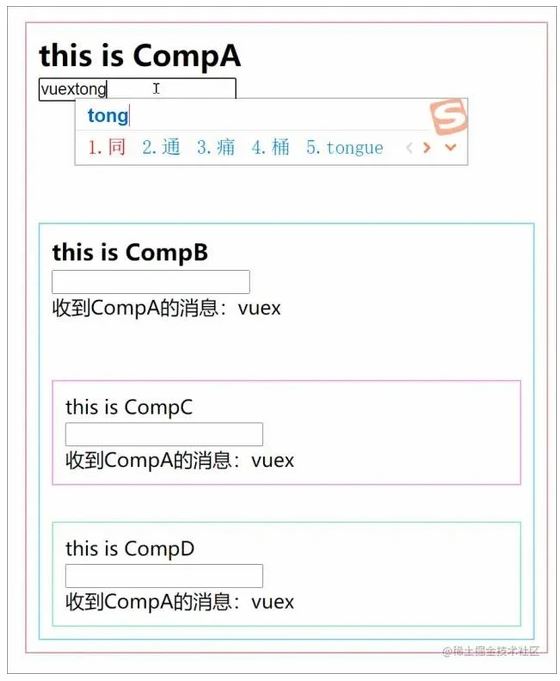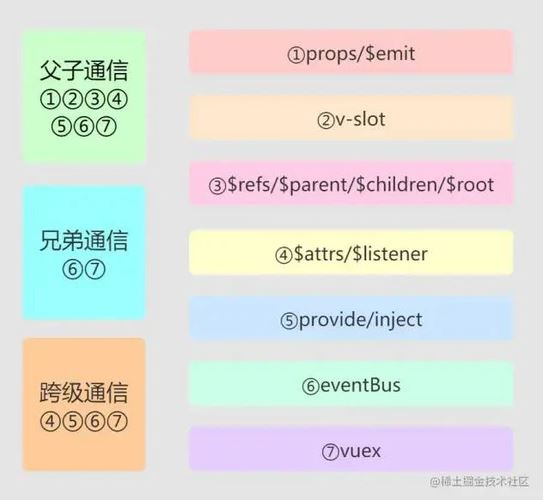怎样深入了解Vue组件七种通信方式,相信很多没有经验的人对此束手无策,为此本文总结了问题出现的原因和解决方法,通过这篇文章希望你能解决这个问题。
vue组件通信的方式,这是在面试中一个非常高频的问题,我刚开始找实习便经常遇到这个问题,当时只知道回到props和 $emit,后来随着学习的深入,才发现vue组件的通信方式竟然有这么多!
今天对vue组件通信方式进行一下总结,如写的有疏漏之处还请大家留言。
1. props/$emit
简介
props和 $emit相信大家十分的熟悉了,这是我们最常用的vue通信方式。
props:props可以是数组或对象,用于接收来自父组件通过v-bind传递的数据。当props为数组时,直接接收父组件传递的属性;当 props 为对象时,可以通过type、default、required、validator等配置来设置属性的类型、默认值、是否必传和校验规则。
$emit:在父子组件通信时,我们通常会使用 $emit来触发父组件v-on在子组件上绑定相应事件的监听。
代码实例
下面通过代码来实现一下props和 $emit的父子组件通信,在这个实例中,我们都实现了以下的通信:
父向子传值:父组件通过 :messageFromParent="message" 将父组件 message 值传递给子组件,当父组件的 input 标签输入时,子组件p标签中的内容就会相应改变。
子向父传值:父组件通过 @on-receive="receive" 在子组件上绑定了 receive 事件的监听,子组件 input 标签输入时,会触发 receive 回调函数, 通过 this.$emit('on-receive', this.message) 将子组件 message 的值赋值给父组件 messageFromChild ,改变父组件p标签的内容。
请看代码:
// 子组件代码<template> <div class="child"> <h5>this is child component</h5> <input type="text" v-model="message" @keyup="send" /> <p>收到来自父组件的消息:{{ messageFromParent }}</p> </div></template><script>export default { name: 'Child', props: ['messageFromParent'], // 通过props接收父组件传过来的消息 data() { return { message: '', } }, methods: { send() { this.$emit('on-receive', this.message) // 通过 $emit触发on-receive事件,调用父组件中receive回调,并将this.message作为参数 }, },}</script>// 父组件代码<template> <div class="parent"> <h4>this is parent component</h4> <input type="text" v-model="message" /> <p>收到来自子组件的消息:{{ messageFromChild }}</p> <Child :messageFromParent="message" @on-receive="receive" /> </div></template><script>import Child from './child'export default { name: 'Parent', data() { return { message: '', // 传递给子组件的消息 messageFromChild: '', } }, components: { Child, }, methods: { receive(msg) { // 接受子组件的信息,并将其赋值给messageFromChild this.messageFromChild = msg }, },}</script>效果预览

2. v-slot
简介
v-slot是 Vue2.6 版本中新增的用于统一实现插槽和具名插槽的api,用于替代 slot(2.6.0废弃) 、 slot-scope(2.6.0废弃) 、 scope(2.5.0废弃) 等api。
v-slot在 template 标签中用于提供具名插槽或需要接收 prop 的插槽,如果不指定 v-slot ,则取默认值 default 。
代码实例
下面请看v-slot的代码实例,在这个实例中我们实现了:
父向子传值:父组件通过 <template v-slot:child>{{ message }}</template> 将父组件的message值传递给子组件,子组件通过 <slot name="child"></slot> 接收到相应内容,实现了父向子传值。
// 子组件代码<template> <div class="child"> <h5>this is child component</h5> <p>收到来自父组件的消息: <slot name="child"></slot> <!--展示父组件通过插槽传递的{{message}}--> </p> </div></template><template> <div class="parent"> <h4>this is parent component</h4> <input type="text" v-model="message" /> <Child> <template v-slot:child> {{ message }} <!--插槽要展示的内容--> </template> </Child> </div></template><script>import Child from './child'export default { name: 'Parent', data() { return { message: '', } }, components: { Child, },}</script>效果预览

3. $refs/ $parent/ $children/$root
简介
我们也同样可以通过 $refs/$parent/$children/$root 等方式获取 Vue 组件实例,得到实例上绑定的属性及方法等,来实现组件之间的通信。
$refs:我们通常会将 $refs绑定在DOM元素上,来获取DOM元素的 attributes。在实现组件通信上,我们也可以将 $refs 绑定在子组件上,从而获取子组件实例。
$parent:我们可以在 Vue 中直接通过 this.$parent 来获取当前组件的父组件实例(如果有的话)。
$children:同理,我们也可以在 Vue 中直接通过 this.$children 来获取当前组件的子组件实例的数组。但是需要注意的是, this.$children 数组中的元素下标并不一定对用父组件引用的子组件的顺序,例如有异步加载的子组件,可能影响其在 children 数组中的顺序。所以使用时需要根据一定的条件例如子组件的name去找到相应的子组件。
$root:获取当前组件树的根 Vue 实例。如果当前实例没有父实例,此实例将会是其自己。通过 $root ,我们可以实现组件之间的跨级通信。
代码实例
下面来看一个 $ parent 和 $ children 使用的实例(由于这几个api的使用方式大同小异,所以关于 $ refs 和 $ root 的使用就不在这里展开了,在这个实例中实现了:
父向子传值:子组件通过 $parent.message 获取到父组件中message的值。
子向父传值:父组件通过 $children 获取子组件实例的数组,在通过对数组进行遍历,通过实例的 name 获取到对应 Child1 子组件实例将其赋值给 child1,然后通过 child1.message 获取到 Child1 子组件的message。
代码如下:
// 子组件<template> <div class="child"> <h5>this is child component</h5> <input type="text" v-model="message" /> <p>收到来自父组件的消息:{{ $parent.message }}</p> <!--展示父组件实例的message--> </div></template><script>export default { name: 'Child1', data() { return { message: '', // 父组件通过this.$children可以获取子组件实例的message } },}</script>// 父组件<template> <div class="parent"> <h4>this is parent component</h4> <input type="text" v-model="message" /> <p>收到来自子组件的消息:{{ child1.message }}</p> <!--展示子组件实例的message--> <Child /> </div></template><script>import Child from './child'export default { name: 'Parent', data() { return { message: '', child1: {}, } }, components: { Child, }, mounted() { this.child1 = this.$children.find((child) => { return child.$options.name === 'Child1' // 通过options.name获取对应name的child实例 }) },}</script>效果预览

4. $attrs/$listener
简介
$ attrs和 $ listeners 都是 Vue2.4 中新增加的属性,主要是用来供使用者用来开发高级组件的。
$attrs:用来接收父作用域中不作为 prop 被识别的 attribute 属性,并且可以通过 v-bind="$attrs" 传入内部组件——在创建高级别的组件时非常有用。
试想一下,当你创建了一个组件,你要接收 param1 、param2、param3 …… 等数十个参数,如果通过 props,那你需要通过 props: ['param1', 'param2', 'param3', ……] 等声明一大堆。如果这些 props 还有一些需要往更深层次的子组件传递,那将会更加麻烦。
而使用 $attrs ,你不需要任何声明,直接通过 $attrs.param1 、 $attrs.param2 ……就可以使用,而且向深层子组件传递上面也给了示例,十分方便。
$listeners:包含了父作用域中的 v-on 事件监听器。它可以通过 v-on="$listeners" 传入内部组件——在创建更高层次的组件时非常有用,这里在传递时的使用方法和 $attrs 十分类似。
代码实例
在这个实例中,共有三个组件:A、B、C,其关系为:[ A [ B [C] ] ],A为B的父组件,B为C的父组件。即:1级组件A,2级组件B,3级组件C。我们实现了:
父向子传值:1级组件A通过 :messageFromA="message" 将 message 属性传递给2级组件B,2级组件B通过 $attrs.messageFromA 获取到1级组件A的 message 。
:messageFromA="message"v-bind="$attrs"$attrs.messageFromA子向父传值:1级组件A通过 @keyup="receive" 在子孙组件上绑定keyup事件的监听,2级组件B在通过 v-on="$listeners" 来将 keyup 事件绑定在其 input 标签上。当2级组件B input 输入框输入时,便会触发1级组件A的receive回调,将2级组件B的 input 输入框中的值赋值给1级组件A的 messageFromComp ,从而实现子向父传值。
@keyup="receive"<CompC v-on="$listeners" />v-on="$listeners"代码如下:
// 3级组件C<template> <div class="compc"> <h6>this is C component</h6> <input name="compC" type="text" v-model="message" v-on="$listeners" /> <!--将A组件keyup的监听回调绑在该input上--> <p>收到来自A组件的消息:{{ $attrs.messageFromA }}</p> </div></template><script>export default { name: 'Compc', data() { return { message: '', } },}</script>// 2级组件B<template> <div class="compb"> <h5>this is B component</h5> <input name="compB" type="text" v-model="message" v-on="$listeners" /> <!--将A组件keyup的监听回调绑在该input上--> <p>收到来自A组件的消息:{{ $attrs.messageFromA }}</p> <CompC v-bind="$attrs" v-on="$listeners" /> <!--将A组件keyup的监听回调继续传递给C组件,将A组件传递的attrs继续传递给C组件--> </div></template><script>import CompC from './compC'export default { name: 'CompB', components: { CompC, }, data() { return { message: '', } },}</script>// A组件<template> <div class="compa"> <h4>this is A component</h4> <input type="text" v-model="message" /> <p>收到来自{{ comp }}的消息:{{ messageFromComp }}</p> <CompB :messageFromA="message" @keyup="receive" /> <!--监听子孙组件的keyup事件,将message传递给子孙组件--> </div></template><script>import CompB from './compB'export default { name: 'CompA', data() { return { message: '', messageFromComp: '', comp: '', } }, components: { CompB, }, methods: { receive(e) { // 监听子孙组件keyup事件的回调,并将keyup所在input输入框的值赋值给messageFromComp this.comp = e.target.name this.messageFromComp = e.target.value }, },}</script>效果预览

5. provide/inject
简介
provide/inject这对选项需要一起使用,以允许一个祖先组件向其所有子孙后代注入一个依赖,不论组件层次有多深,并在其上下游关系成立的时间里始终生效。如果你是熟悉React的同学,你一定会立刻想到Context这个api,二者是十分相似的。
provide:是一个对象,或者是一个返回对象的函数。该对象包含可注入其子孙的 property ,即要传递给子孙的属性和属性值。
injcet:一个字符串数组,或者是一个对象。当其为字符串数组时,使用方式和props十分相似,只不过接收的属性由data变成了provide中的属性。当其为对象时,也和props类似,可以通过配置default和from等属性来设置默认值,在子组件中使用新的命名属性等。
代码实例
这个实例中有三个组件,1级组件A,2级组件B,3级组件C:[ A [ B [C] ] ],A是B的父组件,B是C的父组件。实例中实现了:
父向子传值:1级组件A通过provide将message注入给子孙组件,2级组件B通过 inject: ['messageFromA'] 来接收1级组件A中的message,并通过 messageFromA.content 获取1级组件A中message的content属性值。
跨级向下传值:1级组件A通过provide将message注入给子孙组件,3级组件C通过 inject: ['messageFromA'] 来接收1级组件A中的message,并通过 messageFromA.content 获取1级组件A中message的content属性值,实现跨级向下传值。
代码如下:
// 1级组件A<template> <div class="compa"> <h4>this is A component</h4> <input type="text" v-model="message.content" /> <CompB /> </div></template><script>import CompB from './compB'export default { name: 'CompA', provide() { return { messageFromA: this.message, // 将message通过provide传递给子孙组件 } }, data() { return { message: { content: '', }, } }, components: { CompB, },}</script>// 2级组件B<template> <div class="compb"> <h5>this is B component</h5> <p>收到来自A组件的消息:{{ messageFromA && messageFromA.content }}</p> <CompC /> </div></template><script>import CompC from './compC'export default { name: 'CompB', inject: ['messageFromA'], // 通过inject接受A中provide传递过来的message components: { CompC, },}</script>// 3级组件C<template> <div class="compc"> <h6>this is C component</h6> <p>收到来自A组件的消息:{{ messageFromA && messageFromA.content }}</p> </div></template><script>export default { name: 'Compc', inject: ['messageFromA'], // 通过inject接受A中provide传递过来的message}</script>注意点:
可能有同学想问我上面1级组件A中的message为什么要用object类型而不是string类型,因为在vue provide 和 inject 绑定并不是可响应的。如果message是string类型,在1级组件A中通过input输入框改变message值后无法再赋值给messageFromA,如果是object类型,当对象属性值改变后,messageFromA里面的属性值还是可以随之改变的,子孙组件inject接收到的对象属性值也可以相应变化。
子孙provide和祖先同样的属性,会在后代中覆盖祖先的provide值。例如2级组件B中也通过provide向3级组件C中注入一个messageFromA的值,则3级组件C中的messageFromA会优先接收2级组件B注入的值而不是1级组件A。
效果预览

6. eventBus
简介
eventBus又称事件总线,通过注册一个新的Vue实例,通过调用这个实例的 $ emit 和 $ on等来监听和触发这个实例的事件,通过传入参数从而实现组件的全局通信。它是一个不具备 DOM 的组件,有的仅仅只是它实例方法而已,因此非常的轻便。
我们可以通过在全局Vue实例上注册:
// main.jsVue.prototype.$Bus = new Vue()但是当项目过大时,我们最好将事件总线抽象为单个文件,将其导入到需要使用的每个组件文件中。这样,它不会污染全局命名空间:
// bus.js,使用时通过import引入import Vue from 'vue'export const Bus = new Vue()原理分析
eventBus的原理其实比较简单,就是使用订阅-发布模式,实现 $ emit 和 $ on两个方法即可:
// eventBus原理export default class Bus { constructor() { this.callbacks = {} } $on(event, fn) { this.callbacks[event] = this.callbacks[event] || [] this.callbacks[event].push(fn) } $emit(event, args) { this.callbacks[event].forEach((fn) => { fn(args) }) }}// 在main.js中引入以下// Vue.prototype.$bus = new Bus()代码实例
在这个实例中,共包含了4个组件:[ A [ B [ C、D ] ] ],1级组件A,2级组件B,3级组件C和3级组件D。我们通过使用eventBus实现了:
全局通信:即包括了父子组件相互通信、兄弟组件相互通信、跨级组件相互通信。4个组件的操作逻辑相同,都是在input输入框时,通过 this.$bus.$emit('sendMessage', obj) 触发sendMessage事件回调,将sender和message封装成对象作为参数传入;同时通过 this.$bus.$on('sendMessage', obj) 监听其他组件的sendMessage事件,实例当前组件示例sender和message的值。这样任一组件input输入框值改变时,其他组件都能接收到相应的信息,实现全局通信。
代码如下:
// main.jsVue.prototype.$bus = new Vue()// 1级组件A<template> <div class="containerA"> <h3>this is CompA</h3> <input type="text" v-model="message" @keyup="sendMessage" /> <p v-show="messageFromBus && sender !== $options.name"> 收到{{ sender }}的消息:{{ messageFromBus }} </p> <CompB /> </div></template><script>import CompB from './compB'export default { name: 'CompA', components: { CompB, }, data() { return { message: '', messageFromBus: '', sender: '', } }, mounted() { this.$bus.$on('sendMessage', (obj) => { // 通过eventBus监听sendMessage事件 const { sender, message } = obj this.sender = sender this.messageFromBus = message }) }, methods: { sendMessage() { this.$bus.$emit('sendMessage', { // 通过eventBus触发sendMessage事件 sender: this.$options.name, message: this.message, }) }, },}</script>// 2级组件B<template> <div class="containerB"> <h4>this is CompB</h4> <input type="text" v-model="message" @keyup="sendMessage" /> <p v-show="messageFromBus && sender !== $options.name"> 收到{{ sender }}的消息:{{ messageFromBus }} </p> <CompC /> <CompD /> </div></template><script>import CompC from './compC'import CompD from './compD'export default { name: 'CompB', components: { CompC, CompD, }, data() { return { message: '', messageFromBus: '', sender: '', } }, mounted() { this.$bus.$on('sendMessage', (obj) => { // 通过eventBus监听sendMessage事件 const { sender, message } = obj this.sender = sender this.messageFromBus = message }) }, methods: { sendMessage() { this.$bus.$emit('sendMessage', { // 通过eventBus触发sendMessage事件 sender: this.$options.name, message: this.message, }) }, },}</script>// 3级组件C<template> <div class="containerC"> <p>this is CompC</p> <input type="text" v-model="message" @keyup="sendMessage" /> <p v-show="messageFromBus && sender !== $options.name"> 收到{{ sender }}的消息:{{ messageFromBus }} </p> </div></template><script>export default { name: 'CompC', data() { return { message: '', messageFromBus: '', sender: '', } }, mounted() { this.$bus.$on('sendMessage', (obj) => { // 通过eventBus监听sendMessage事件 const { sender, message } = obj this.sender = sender this.messageFromBus = message }) }, methods: { sendMessage() { this.$bus.$emit('sendMessage', { // 通过eventBus触发sendMessage事件 sender: this.$options.name, message: this.message, }) }, },}</script>// 3级组件D<template> <div class="containerD"> <p>this is CompD</p> <input type="text" v-model="message" @keyup="sendMessage" /> <p v-show="messageFromBus && sender !== $options.name"> 收到{{ sender }}的消息:{{ messageFromBus }} </p> </div></template><script>export default { name: 'CompD', data() { return { message: '', messageFromBus: '', sender: '', } }, mounted() { this.$bus.$on('sendMessage', (obj) => { // 通过eventBus监听sendMessage事件 const { sender, message } = obj this.sender = sender this.messageFromBus = message }) }, methods: { sendMessage() { this.$bus.$emit('sendMessage', { // 通过eventBus触发sendMessage事件 sender: this.$options.name, message: this.message, }) }, },}</script>效果预览

图片过大,截图处理
7. Vuex
当项目庞大以后,在多人维护同一个项目时,如果使用事件总线进行全局通信,容易让全局的变量的变化难以预测。于是有了Vuex的诞生。
Vuex 是一个专为 Vue.js 应用程序开发的状态管理模式。它采用集中式存储管理应用的所有组件的状态,并以相应的规则保证状态以一种可预测的方式发生变化。
有关Vuex的内容,可以参考 Vuex官方文档 [1] ,我就不在这里班门弄斧了,直接看代码。
代码实例
Vuex的实例和事件总线leisi,同样是包含了4个组件:[ A [ B [ C、D ] ] ],1级组件A,2级组件B,3级组件C和3级组件D。我们在这个实例中实现了:
全局通信:代码的内容和eventBus也类似,不过要比eventBus使用方便很多。每个组件通过watch监听input输入框的变化,把input的值通过vuex的commit触发mutations,从而改变stroe的值。然后每个组件都通过computed动态获取store中的数据,从而实现全局通信。
// store.jsimport Vue from 'vue'import Vuex from 'vuex'Vue.use(Vuex)export default new Vuex.Store({ state: { message: { sender: '', content: '', }, }, mutations: { sendMessage(state, obj) { state.message = { sender: obj.sender, content: obj.content, } }, },})// 组件A<template> <div class="containerA"> <h3>this is CompA</h3> <input type="text" v-model="message" /> <p v-show="messageFromStore && sender !== $options.name"> 收到{{ sender }}的消息:{{ messageFromStore }} </p> <CompB /> </div></template><script>import CompB from './compB'export default { name: 'CompA', components: { CompB, }, data() { return { message: '', } }, computed: { messageFromStore() { return this.$store.state.message.content }, sender() { return this.$store.state.message.sender }, }, watch: { message(newValue) { this.$store.commit('sendMessage', { sender: this.$options.name, content: newValue, }) }, },}</script>同样和eventBus中一样,B,C,D组件中的代码除了引入子组件的不同,script部分都是一样的,就不再往上写了。
效果预览

总结
上面总共提到了7中Vue的组件通信方式,他们能够进行的通信种类如下图所示:

props/$emit:可以实现父子组件的双向通信,在日常的父子组件通信中一般会作为我们的最常用选择。
v-slot:可以实现父子组件单向通信(父向子传值),在实现可复用组件,向组件中传入DOM节点、html等内容以及某些组件库的表格值二次处理等情况时,可以优先考虑v-slot。
$ refs/$ parent/ $ children/ $ r oot: 可 以实现父子组件双向通信,其中 $root可以实现根组件实例向子孙组件跨级单向传值。 在父组件没有传递值或通过v-on绑定监听时,父子间想要获取彼此的属性或方法可以考虑使用这些api。
$ attrs/ $ listeners: 能够实现跨级双向通信,能够让你简单的获取传入的属性和绑定的监听,并且方便地向下级子组件传递,在构建高级组件时十分好用。
provide/inject:可以实现跨级单向通信,轻量地向子孙组件注入依赖,这是你在实现高级组件、创建组件库时的不二之选。
eventBus:可以实现全局通信,在项目规模不大的情况下,可以利用eventBus实现全局的事件监听。但是eventBus要慎用,避免全局污染和内存泄漏等情况。
Vuex:可以实现全局通信,是vue项目全局状态管理的最佳实践。在项目比较庞大,想要集中式管理全局组件状态时,那么安装Vuex准没错!
看完上述内容,你们掌握怎样深入了解Vue组件七种通信方式的方法了吗?如果还想学到更多技能或想了解更多相关内容,欢迎关注编程网行业资讯频道,感谢各位的阅读!




